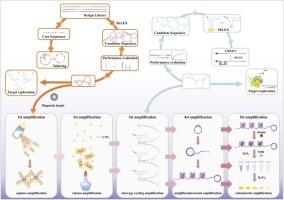阪崎克罗诺杆菌DNAzymes和适配体的精确筛选及超灵敏等温集成生物传感器检测
IF 11.3
1区 环境科学与生态学
Q1 ENGINEERING, ENVIRONMENTAL
引用次数: 0
摘要
阪崎克罗诺杆菌(C. sakazakii)是一种对不良环境具有耐药性的机会致病菌,可在婴儿中诱发脑膜炎和败血症,死亡率高,需要超灵敏检测。本研究通过剪裁现有的阪崎c适配体,得到核心结合区,并基于该核心序列设计了具有高亲和力和特异性的新型适配体筛选文库。此外,我们进行了C. sakazakii DNAzyme的首次筛选,并借助分子对接技术探索了其结合位点。基于适体、DNAzyme、g -四联体和RCA反应,研制了一种超灵敏的视觉阪崎c传感器。该传感器通过适配体-磁珠连接实现阪崎c富集,并通过DNAzyme将细菌计数信号转化为核酸计数信号。滚动圆放大(RCA)产生大量的g -四重信号,用于指数级信号放大;g -四联体与血红蛋白形成的络合物催化TMB显色,完成最终的视觉信号输出。在优化条件下,传感器在9×100 ~ 9×103 CFU/mL范围内呈线性关系,线性方程为y=0.2282LgC + 0.1957 (R2=0.9992),检出限为2 CFU/mL。综上所述,本研究开发了一种基于多种功能核酸的超灵敏阪崎僵菌检测传感器。本文章由计算机程序翻译,如有差异,请以英文原文为准。

Precision Screening of DNAzymes and Aptamers, and an Ultrasensitive Isothermal Integrated Biosensor for Cronobacter sakazakii Detection
Cronobacter sakazakii (C. sakazakii), an opportunistic pathogenic bacterium resistant to adverse environments, can induce meningitis and sepsis in infants with high mortality, which necessitates ultra-sensitive detection. In this study, the core binding region was derived by tailoring existing C. sakazakii aptamer, and novel aptamer screening libraries were designed based on this core sequences with high affinity and specificity. Additionally, we performed the first screening of C. sakazakii DNAzyme and explored its binding sites with the aid of molecular docking. Based on the aptamer, DNAzyme, G-quadruplex, and RCA reaction, an ultra-sensitive visual C. sakazakii sensor was developed. This sensor achieves C. sakazakii enrichment via aptamer-magnetic bead conjunction and converts bacterial count to nucleic acid count signals through DNAzyme. Rolling circle amplification (RCA) generates massive G-quadruplexes for exponential signal amplification; the complex formed by G-quadruplex and hemin catalyzes TMB chromogenesis to complete the final visual signal output. Under optimized conditions, the sensor exhibits a linear relationship in the range of 9×100 ~ 9×103 CFU/mL, with a linear equation of y=0.2282LgC + 0.1957 (R2=0.9992) and a limit of detection (LOD) of 2 CFU/mL. In summary, this study developed an ultra-sensitive sensor based on multiple functional nucleic acids for C. sakazakii detection.
求助全文
通过发布文献求助,成功后即可免费获取论文全文。
去求助
来源期刊

Journal of Hazardous Materials
工程技术-工程:环境
CiteScore
25.40
自引率
5.90%
发文量
3059
审稿时长
58 days
期刊介绍:
The Journal of Hazardous Materials serves as a global platform for promoting cutting-edge research in the field of Environmental Science and Engineering. Our publication features a wide range of articles, including full-length research papers, review articles, and perspectives, with the aim of enhancing our understanding of the dangers and risks associated with various materials concerning public health and the environment. It is important to note that the term "environmental contaminants" refers specifically to substances that pose hazardous effects through contamination, while excluding those that do not have such impacts on the environment or human health. Moreover, we emphasize the distinction between wastes and hazardous materials in order to provide further clarity on the scope of the journal. We have a keen interest in exploring specific compounds and microbial agents that have adverse effects on the environment.
 求助内容:
求助内容: 应助结果提醒方式:
应助结果提醒方式:


